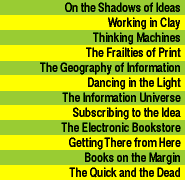


Working in Clay
Over the past fifty years, printing, paper, and transportation costs have all risen, while the cost of their electronic counterparts---computing, electronic memory, and telecommunications---have roughly halved every two years. Now the two cost curves have crossed, and it's cheaper to make and distribute electronic books than it is to print paper ones. The only thing holding electronic books back is the lack of cheap, sturdy, portable, high-definition electronic displays. Within a decade that will change. After five hundred years of business as usual, publishing is once again about to change---drastically.Of course, paper books still have some pluses. They are hard to break. They don't need batteries. They're readable in the bathtub and in strong sunlight. They've been around for over five hundred years, and all literates know how to use them.
But they have minuses, too. Illiterates can't use them. They don't talk to us, adapt to us, or have animated illustrations or music. They don't let us change font size at will or zoom or pan illustrations; nor do they recognize voice commands or visual cues. They make it hard to combine the information in different parts of one book or in many books on related subjects. They aren't easy to turn into Braille or big print. They aren't cheap, long lasting, or easy to copy, obtain, or search. They certainly are not portable in bulk.
Electronic books could be all these things and yet retain many of the pluses of paper books. We could handwrite marginal notes, highlight them with colored markers, and put bookmarks in them. Cross-referencing could be either reader-controlled or computer-generated. Books could be customized by---or for---their readers; each copy need not be exactly the same.
Electronic books could also let authors mix voice, music, color, video, pictures, numbers, and text. Today's automated book-reading machines can even read the text of any printed book out loud---a boon to the blind, disabled, illiterate, or busy.
Perhaps a single electronic book might, in the future, become a whole library of children's books. The book could listen to the parent (or child) reading aloud for a few hours until it can read any of its repertoire of books in that person's voice. Imagine children's books that can read themselves to a child at bedtime. By listening to the child's breathing, the book could reduce its volume, dim the lights, and slow its cadence as the child drops off to sleep. Of course, it can't kiss the child goodnight. But then, neither can a paper book.
In sum, about all we can really say in paper's favor is that it's lighter than clay, less awkward than papyrus, and cheaper than parchment.